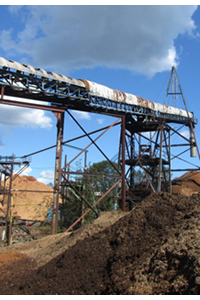Sawmill damaged by fire when hog fuel ignited
Date of incident: July 2016
Notice of incident number: 2016173460016
Employer: Sawmill
Incident summary
At a sawmill, a smouldering fire occurred in the hog, a machine that creates hog fuel (a wood waste product). Workers put this small fire out by dousing it with water from a hose. A firebrand (piece of burning wood) left the hog and travelled up two outfeed conveyors. The conveyors were stopped, and a worker dealt with the firebrand that had escaped from the hog fire. Ten minutes later, a second fire started in a pile of hog fuel, near the top of one of the outfeed conveyors. Workers attempted to fight the fire but were unable to stop its progress due to high winds and other flammable materials in the mill yard. Another hog fuel conveyor caught fire and spread the flames to several piles of wood waste products and structures. The mill sustained significant damage as a result of these fires. No workers were injured.
Investigation conclusions
Cause
- Friction fire started in hog due to inadequate machine maintenance. The original fire started as a result of friction between the rotating equipment and trapped wood waste inside the hog machine. Friction fires occur when gaps between the hog rotor and side plates develop due to lapses in maintenance. Fires in the hog occurred routinely and were dealt with when detected by spraying water into the hog.
Contributing factors
- Hog fuel accumulation on and under conveyors. Hog fuel was allowed to accumulate on the ground below the transfer point between two conveyors. The hog fuel on the ground dried in the hot summer sun and presented a ready fuel source for fire when a firebrand transported by the hog outfeed conveyor belts dropped onto the pile. Failure to adequately control the accumulation of hog fuel was a factor in this incident. Routine cleanup and removal would have reduced the available fuel load for this fire.
- Inadequate training and fire procedures. Fire response training would have assisted mill workers to properly respond to small fires before the fires spread or became uncontrollable. Posting a worker to act as fire watch after the initial fire was extinguished might have resulted in detection of the second fire, which rapidly grew and spread to flammable hog fuel piles. Adequate fire response procedures and appropriate training of workers would have prevented the fire from being transferred from the hog to the outfeed conveyors.
- Inadequate fire detection. There was no method for detecting smouldering fires other than the observation of passersby. Smoke detectors might have prevented this fire.

